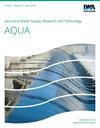抽水配水管网区域计水区设计的多目标优化工具
IF 4.3
Q2 Environmental Science
引用次数: 0
摘要
建立区域水表区是缓解供水管网运行管理困难、提高管网效率的有效方法。有几个与DMA设计相关的目标取决于受其形成影响的网络参数。之前的两项研究将抽水管网和重力管网的DMA设计分别视为三目标问题(运行成本、平均压力和水龄)和四目标问题(设计成本、压力偏差、弹性指数(RI)和需求缺口)。这些问题分别通过使用NSGA-II和NSGA-III优化工具实施多阶段DMA设计方法来解决。目前的工作建立在以前的研究基础上,同时考虑了DMA设计中的五个目标(即设计成本、运行成本、RI、平均压力和水龄),并使用NSGA-III优化工具在抽水管网中进行优化。在这种扩展方法中,泵在满足节点需求方面的作用消除了将需求不足作为目标之一的必要性。所提出的方法已经在两个基准网络上进行了评估,证明了其识别DMA替代方案和提供基于用户偏好的解决方案的能力。最后,将所得结果与前人的研究结果进行了比较。本文章由计算机程序翻译,如有差异,请以英文原文为准。
Many-objective optimisation tool for the design of district metered areas in pumped water distribution networks
The establishment of district metered areas (DMAs) is a highly effective method to mitigate operational management difficulties and enhance the efficiency of water distribution networks (WDNs). There are several objectives associated with the DMA's design that are contingent upon the network parameters that are affected by its formation. Two previous studies considered DMA design as a three-objective problem (operational cost, average pressure and water age) and a four-objective problem (design cost, pressure deviation, resilience index (RI) and demand shortfall) for pumped and gravity networks, respectively. The problems were addressed through the implementation of a multi-phase DMA design methodology using the NSGA-II and NSGA-III optimisation tools, respectively. The present work builds upon previous research by simultaneously considering five objectives in DMA design (i.e. design cost, operational cost, RI, average pressure and water age) using the NSGA-III optimisation tool in pumped water networks. In this extended approach, the pump's role in meeting nodal demands eliminates the necessity of including demand shortfall as one of the objectives. The proposed methodology has been evaluated on two benchmark networks, demonstrating its capability to identify DMA alternatives and provide solutions based on user preferences. Finally, the obtained results are compared with the previous study's findings.
求助全文
通过发布文献求助,成功后即可免费获取论文全文。
去求助
来源期刊
CiteScore
4.70
自引率
0.00%
发文量
74
审稿时长
4.5 months
期刊介绍:
Journal of Water Supply: Research and Technology - Aqua publishes peer-reviewed scientific & technical, review, and practical/ operational papers dealing with research and development in water supply technology and management, including economics, training and public relations on a national and international level.

 求助内容:
求助内容: 应助结果提醒方式:
应助结果提醒方式:


